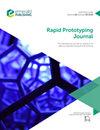激光烧结聚酰胺-12 表面的影响机理研究
IF 3.6
4区 工程技术
Q1 ENGINEERING, MECHANICAL
引用次数: 0
摘要
本文旨在阐明聚合物熔体粘性流动和饰面层粉末颗粒粘附机制对激光烧结聚酰胺 (PA12) 部件顶面形貌的影响程度。使用聚焦变化显微镜深入了解其顶面高度和峰谷分布。随后,生成了前者与应用激光参数相关的回归表达式模型。在测试的参数范围内,这项研究发现激光烧结 PA12 顶表面的均方根(Sq)和偏斜度(Ssk)粗糙度响应彼此成反比关系,并且都主要受光束间距的影响。此外,研究还表明,与标准激光烧结 PA12 顶面相比,使用优化的激光参数(以促进聚合物熔体分散)和不使用饰面层(以避免随后的粉末颗粒粘附),可使所得拓扑图的平均 Sq 粗糙度分别降低 30.8% 和 47.9%。原创性/价值这项研究表明了聚合物熔体粘性流动和饰面层粉末颗粒粘附机制对激光烧结 PA12 顶面的影响。本文章由计算机程序翻译,如有差异,请以英文原文为准。
An investigation into the mechanisms that influence laser sintered polyamide-12 top surfaces
Purpose
The purpose of this paper is to elucidate the extent to which the mechanisms of polymer melt viscous flow and finish layer powder particle adhesion influence the top surface topographies of laser sintered polyamide (PA12) components.
Design/methodology/approach
Laser sintered specimens were manufactured at varying laser parameters in accordance with a full factorial design of experiments. Focus variation microscopy was used to ascertain insight into their top surface heights and peak/valley distributions. Subsequently, regression expressions were generated to model the former with respect to applied laser parameters. Auxiliary experimental analysis was also performed to validate the proposed mechanisms and statistical models.
Findings
Within the parameter range tested, this work found the root mean square (Sq) and skewness (Ssk) roughness responses of laser sintered PA12 top surfaces to be inversely related to one another, and both also principally influenced by beam spacing. Furthermore, it was demonstrated that using optimised laser parameters (to promote polymer melt dispersion) and building without finish layers (to avert subsequent powder particle adhesion) reduced the mean Sq roughness of resultant topographies by 30.8% and 47.9% relative to standard laser sintered PA12 top surfaces, respectively.
Practical implications
The scope to which laser sintered PA12 top surfaces can be modified was highlighted.
Originality/value
This research demonstrated the impact the mechanisms of polymer melt viscous flow and finish layer powder particle adhesion have on laser sintered PA12 top surfaces.
求助全文
通过发布文献求助,成功后即可免费获取论文全文。
去求助
来源期刊

Rapid Prototyping Journal
工程技术-材料科学:综合
CiteScore
8.30
自引率
10.30%
发文量
137
审稿时长
4.6 months
期刊介绍:
Rapid Prototyping Journal concentrates on development in a manufacturing environment but covers applications in other areas, such as medicine and construction. All papers published in this field are scattered over a wide range of international publications, none of which actually specializes in this particular discipline, this journal is a vital resource for anyone involved in additive manufacturing. It draws together important refereed papers on all aspects of AM from distinguished sources all over the world, to give a truly international perspective on this dynamic and exciting area.
-Benchmarking – certification and qualification in AM-
Mass customisation in AM-
Design for AM-
Materials aspects-
Reviews of processes/applications-
CAD and other software aspects-
Enhancement of existing processes-
Integration with design process-
Management implications-
New AM processes-
Novel applications of AM parts-
AM for tooling-
Medical applications-
Reverse engineering in relation to AM-
Additive & Subtractive hybrid manufacturing-
Industrialisation
 求助内容:
求助内容: 应助结果提醒方式:
应助结果提醒方式:


